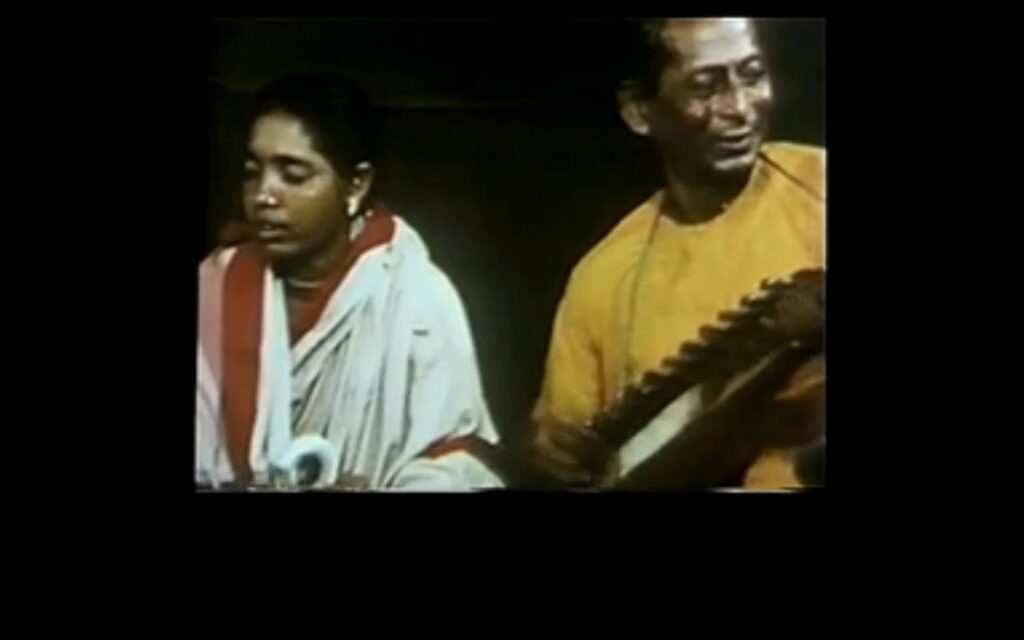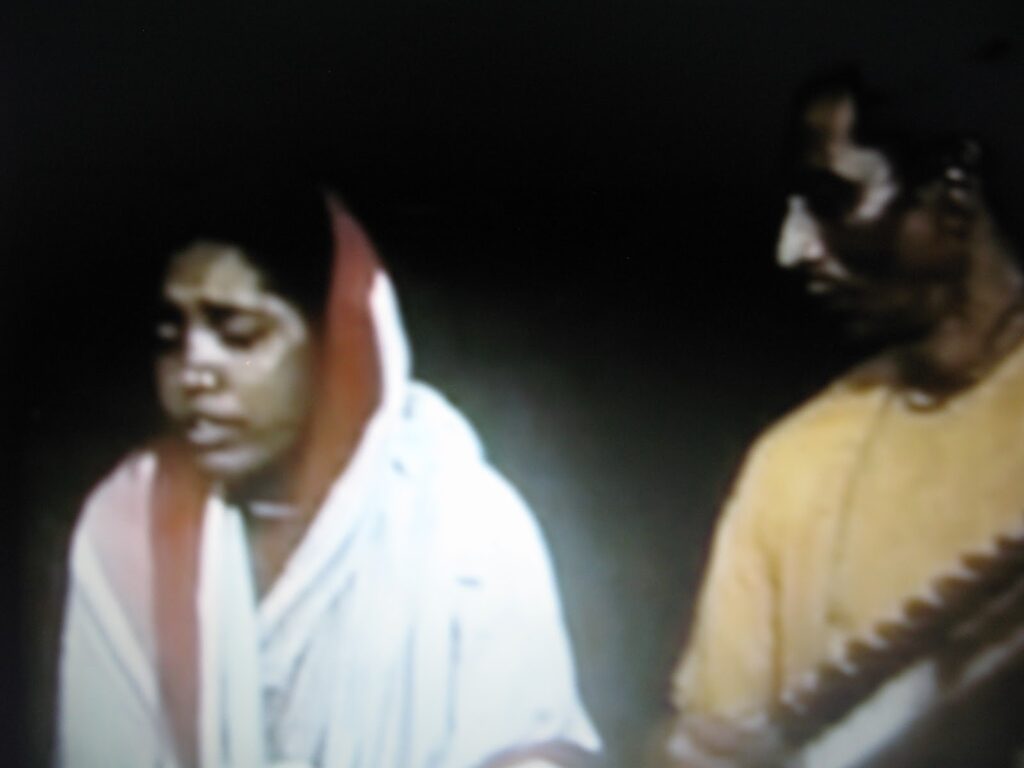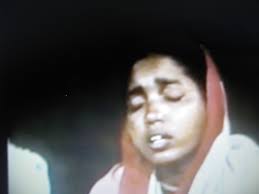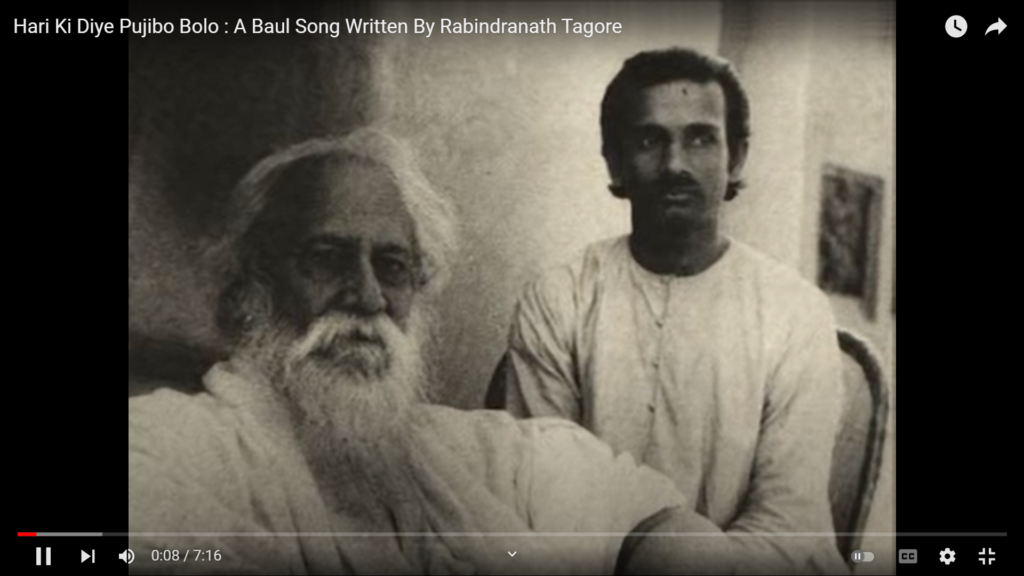
Nabanidas Baul at the third Banga Sankriti Sammelan
This rare and precious recording of Nabani Das Khepa Baul and others would likely have stayed in the British Library Sound Archives, unnoticed, unnamed and unplayed for some more time, had I not accidentally come across it in 2018. I am not making a claim to any special talent as a researcher, but I suppose I was fortunate to have been at the right place at the right time with the right curiosity. I have written a detailed session note on the recording in The Travelling Archive’s Recording Sessions page for 2019. The process of putting the names of the iconic Nabani Das Khepa Baul (1890-1964), his son Purna Das Baul and others to file numbers C52/NEP/67 and 68 was a longwinded journey. It was like an archaeological excavation, এটি একটি খননের গল্প, as I wrote in the Sunday supplement of Ananda Bazar Patrika in August 2020. Young Purna Das Baul was performing at the third Banga Sanskriti Sammelan in Kolkata, with his father Nabani Das in 1956. In 2019, it was very emotional for Purna Das to listen to his father, sister, Radharani, brother-in-law, Gopal Das, and friend, Sudhananda Das Baul, as well as to himself when he was 22, going on 23. It was even more emotional as everyone except Sudhananda is no more. He remembered details of the performance, of the audience, the ambience. Perhaps he was not remembering everything exactly as it happened, but from what he was saying it was clear how things used to happen between them those days, how his father would perform, what they sang and the dynamic on stage.
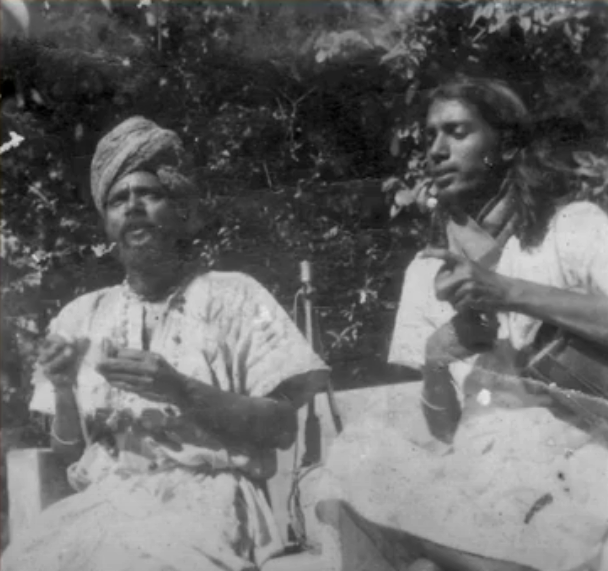
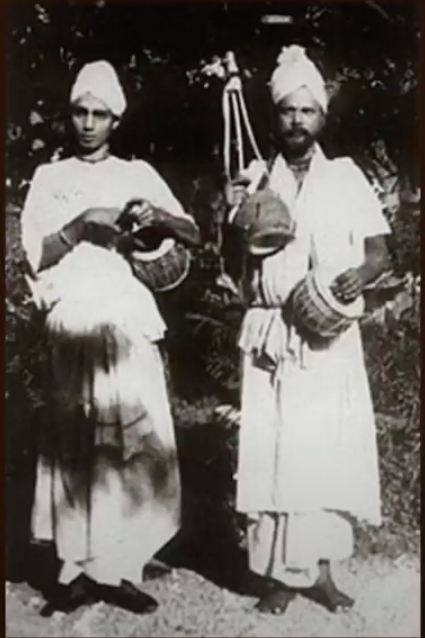
I suppose that in 1956, this is how father and son would have looked. Photos: From Purna Das’ family.
Since my meetings with Purna Das Baul in his home in 2019, and ever since we were able to identify the 1956 reel-to-reel recording of Nabani Das Khepa Baul, and copies were sent by the British Library to his family, after which I wrote my aforementioned session notes and the newspaper article in 2020, I have had some interesting exchanges with other researchers and collectors. I have looked through my own collection and gathered some fresh photos and recordings and other paraphernalia, all related to the Bake baul recordings of 1956. Here is an assemblage of some of that material, dated and labelled, for us to work together later.
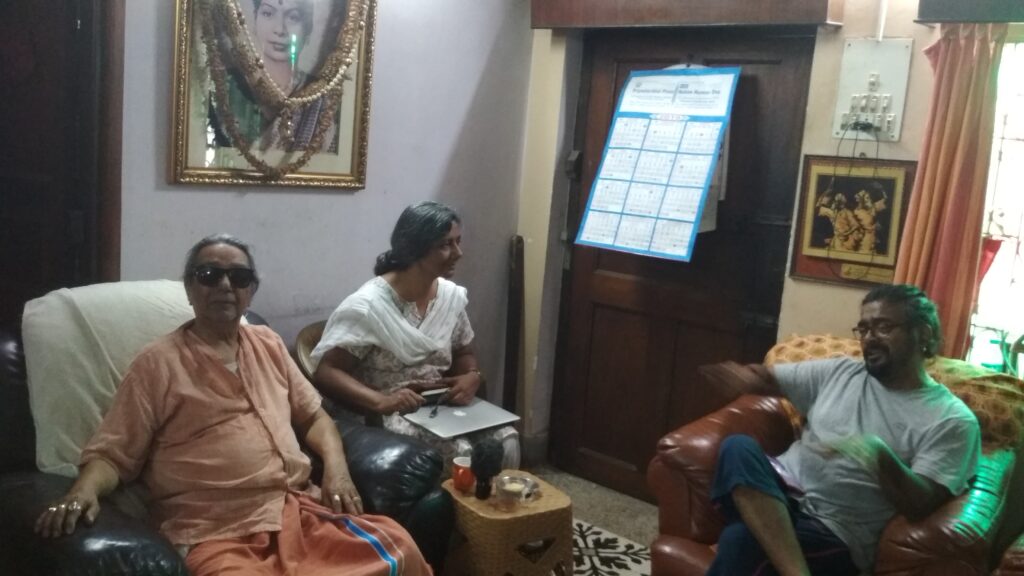
With Purna Das Baul and his son, Dibyendu Das Baul or Chhoton, in their home in Dhakuria, south Kolkata on 6 May 2019. Photo by Aditi Das.
After my Ananda Bazar article came out, and I posted the piece on my Facebook wall on 24 August 2020, researcher and activist Debi Roy wrote a comment about the research and recordings of bauls that they had made at Chitrabani, one of the oldest media training institutes of Kolkata, between 1979 and 1984.
‘নবনী দাসের বিখ্যাত গান, ” ভালো করে পড়গা ইস্কুলে “। রবীন্দ্রনাথের প্রিয় বাউল সাধক। কবি শান্তিনিকেতন গেলেই তাঁর গান শুনতেন। Arnold Bake-এর রেকর্ডিংটা কীভাবে শোনা যাবে?
‘আমি চিত্রবানীতে “বাউল-ফকির প্রজেক্ট ” -এর সঙ্গে 1979-1984 যুক্ত ছিলাম-একজন মাঠ গবেষক হিসাবে কবি দীপক মজুমদারের সঙ্গে। দীপক মজুমদার কৃত্তিবাস পত্রিকার প্রতিষ্ঠাতা ও প্রথম সম্পাদক। তিনি আমার গুরু। আমরা প্রচুর বাউল গান রেকর্ড করি, প্রচুর ইন্টারভিউ নিই বাউলদের, সেই সঙ্গে প্রচুর স্টিল ছবি-চিত্রবানী লাইব্রেরীতে আমার হাতে লেখা ” বাউল প্রসঙ্গে” বলে বাঁধানো বই আকারে আছে। আমার সহযাত্রী ছিলেন-সুনেত্রা ঘটক, গৌতম চ্যাটার্জী (মহীনের ঘোড়াগুলি), সতীনাথ চ্যাটার্জী, অনিরুদ্ধ ধর, সেলিম পাল ও আরো অনেকে। আমি নবনী দাস সমন্ধে জেনেছি-তাঁর মেয়ে রাধারাণী দাসের একটি সাক্ষাৎকার থেকে-সেইটার রেকর্ডিং ছিল-ওই গানটার উল্লেখ ছিল- আর একটা পাঁচসেরি মালা পরে নবনী ক্ষ্যাপা পৌষমেলায়, কলাভবনে নেচে নেচে গান করতেন। তাঁর সমসাময়িক ছিলেন বেতালবনের নিতাই ক্ষ্যাপা আর মনোহর ক্ষ্যাপা। আমি সেইসময় লক্ষণ দাসের সঙ্গে নবনী দাসের ভিটেয় যাই। পূর্ণদাস বাউল আর রাধারাণীর সঙ্গে সেখানেই পরিচয় হয়। এইটুকুই। আমি গোষ্টগোপালের বাবা দীনবন্ধু দাস-বিশাখা দাসীর বাড়িতে গিয়েছি-থেকেছি। দীনবন্ধু আলাউদ্দিন খাঁ সাহেবকে বাউল গান শুনিয়েছিলেন। আর স্বয়ং রবীন্দ্রনাথ নবনী পুত্র পূর্ণদাসকে আশীর্বাদ করে বলেছিলেন, তুমি বিশ্বখ্যাত হবে। এইটুকুই।’
Debi Roy had asked about this song in his note. ‘Bhalo kore por ga iskoole’. A song credited to Nabani Das Baul. I found a video in which Purna Das sings only a few lines of the song. As I listened, I made a recording on my Zoom H2N.
I wrote back to Debi Roy that indeed, I had heard mention of that song and heard people sing it too. ‘হ্যাঁ ওই গানটার প্রসঙ্গ তো বার বার এসেছে, আমার সঙ্গে কথা বলার সময়ও পূর্ণদাস বলেছেন গানটির কথা। আমি যেটা বুঝতে চাইছি তা হলো সবাই বলেন, নানা ভাবে নবনীদাসের রবীন্দ্রনাথের আদর পাবার কথা বলেন, সবার স্মৃতিতে সেই কথা ধরা আছে, তারপর স্মৃতি থেকে স্মৃতিতে বাহিত হয়ে এটি একটি সাধারণ সত্য হয়ে গেছে, যা প্রশ্নাতীত। যে কারণে আমি ঠিক সেইভাবে না লিখলেও আনন্দবাজারের ব্লার্বে এইভাবেই ভূষিত করা হলো নবনীকে–রবীন্দ্রনাথের স্নেহধন্য নবনী বলে। কারণ আমরা এভাবেই জানি। সবাই জানেন। আমিও জানি। প্রশ্নও করছি না। আমি শুধু ভাবি কারো যদি সরাসরি কোনো লেখা থাকতো এই বিষয়ে। আছে নিশ্চয়। আমি তো সব কিছু পড়িনি। […] আমি এটাও বুঝতে চাইছি, নবনীদাস শান্তিনিকেতনে, কলাভবনে কোন সময়টা থেকে আসতে শুরু করলেন। কুড়ির দশকে? তিরিশের দশকে? বাকে সাহেব তাঁকে দেখেছিলেন কি না, এটা তো আমার একটা unresolved প্রশ্ন হয়ে থেকেই যাবে। এই আর কি। চিত্রবাণীর ওই সময়ের কাজ রেকর্ডিং হিসেবেই release করা হতো যদি। না কি, হয়েছে? এত সব অমূল্য জিনিস। আমার আসলে সময় নিয়ে বেশি আগ্রহ। এই সব রেকর্ডিং শুনলে, এইসব গল্প শুনলে অন্য সময়, অন্য মানচিত্রে পৌঁছে যাই। এর বেশি অত কিছু আমি জানি না।’
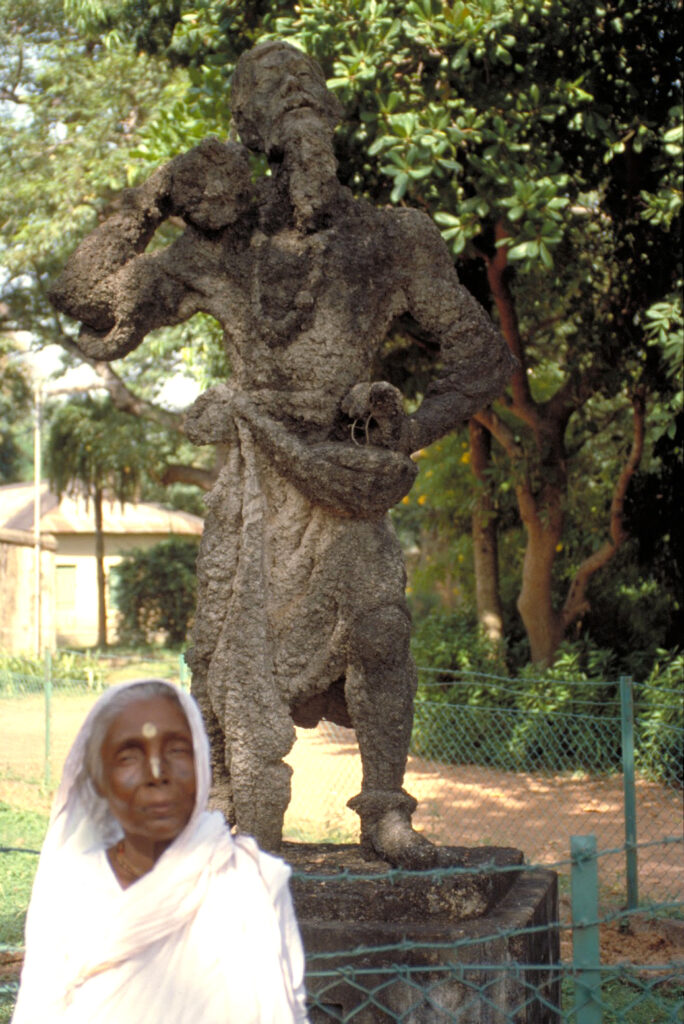
Within the Nabani Das family, there are all sorts of myths which do the rounds. Over the years, Nabani Das , Purna Das and Lakshman (also spelt Laxman and Luxman) Das became part of something big, a kind of establishment, studied by scholars and the latter two recorded by major international labels, performing in music concerts around the world, especially Purna Das Baul. Which is why family members are careful to mark their individual place within that lineage. For example, one of Purna Das’ sons who lives in the USA now, Krishnendu Das Baul aka Babu Kishan Das, makes many claims about Nabani Das ’ associations with Santiniketan, particularly with Tagore. This sculpture is of a baul and it is on the outskirts of Santiniketan. The claim is that it was made by the famous Ramkinkar Baij and was inspired by the figure of Nabani Das Baul. The truth of this claim is disputed by art historians such as Sushovan Adhikary, who is a professor of Kala Bhavan, Santiniketan. But I do not know who made it. Here Nabani Das Baul’s wife, Purna Das-Lakshman Das-Chakradhar-Radharani’s mother, Brajabala is seen standing before the sculpture.
Brajabala sang too and we had talked about her on 6 May 2019.
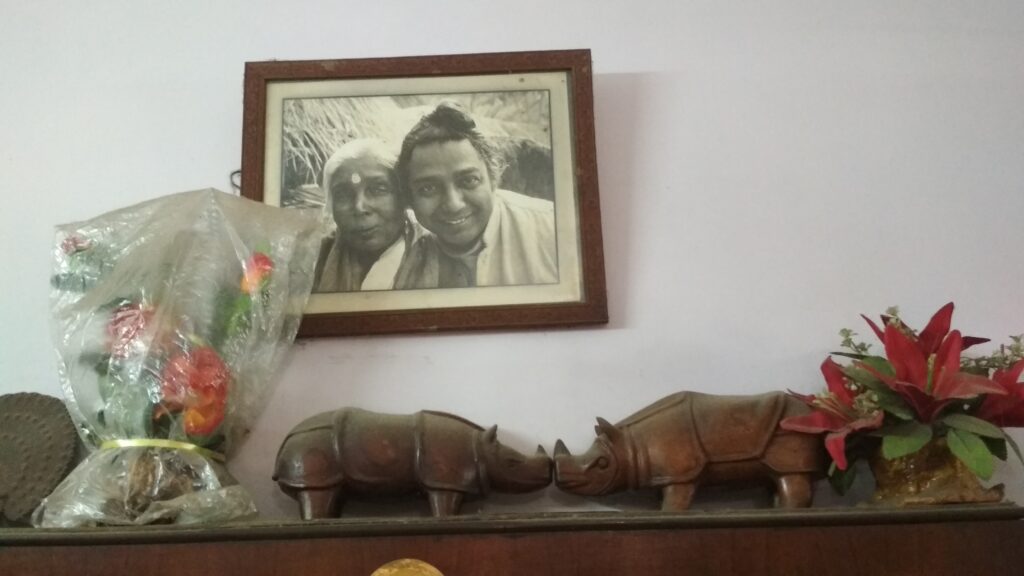
I took this photo in Purna Das Baul’s home in Dhakuria, Kolkata in 2019. The date of the photograph of Purna Das with his mother on the wall is unknown; my guess is that it is from the later part of the 1960s.
On the question of myths surrounding Nabani Das Baul, in a recent article, journalist Snigdhendu Bhattacharya wrote that one of the songs in Purna Das Baul-Lakshman Das Baul’s 1967 album from Elektra, ‘Bauls of Bengal’, ‘Ki Diye Pujibo Hari Charono Tomar’ was ‘one that Tagore composed as a baul and gave Nabani to set to tune’.
Hori ki diye pujibo balo ranga charano tomar/ Ore kon phule pujile balo puja hoy tomar… and then the bhonita, the signature, Thakur Robi bole… How to get to the bottom of this claim? Was it truly a Tagore song set to tune and sung by Nabani Das Baul?
Around the same time when I was working on Arnold Bake’s 1956 recordings, Carola Erika Lorea, a scholar of Bengali oral traditions, led a research under the British Library’s Endangered Archives Project entitled ‘Songs of the Old Madmen’ (2019-2020) in which she is ‘recovering baul songs from the notebooks of 19th and 20th century Bengali saint-poets’. One of the collections which comes out of the project is on and around Nabani Das, in which mainly old notebooks containing texts of songs composed by Nabani and his contemporaries and older bauls have been scanned and digitised. One of chapters of this project is the Mahadeb Das Baul Collection, Mahadeb being the son of Nabani Das’ son Lakshman, whom we had also recorded in Suri in 2009.
One of the notebooks in the Mahadeb Das collection has songs of Nabani Das Baul. In general it has handwritten song texts ‘composed between the 1790s and 1980s. The notebook itself was compiled during the second half of the twentieth century.’
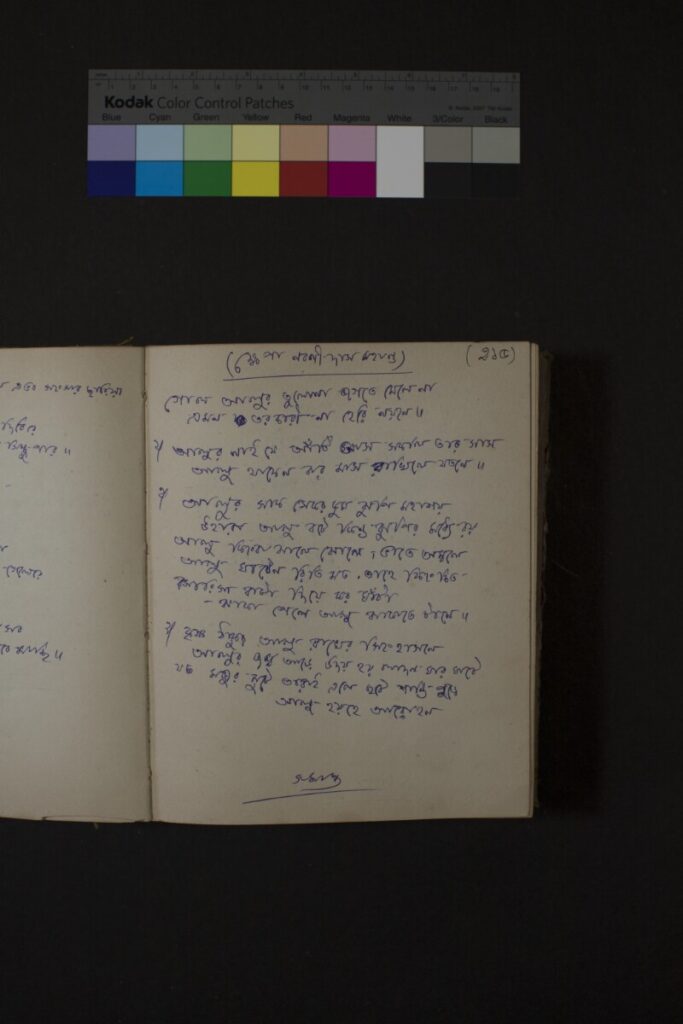
Dowloaded from the British Library archives. This open access file has a Creative Commons attribution non-commercial licence.
Interestingly, I found a clip of the song sung by Purna Das Baul, which I recorded while playing from the Internet.
Carola too wrote to me after my Ananda Bazar article was published. On 27 August 2020, she wrote in an email: ‘My empirical data around Nabani […] comes from various strings that often are not interwoven at all. The Bengali bhadralok and American counterculture is just one stream of threads, and quite rich, relatively speaking; if compared to other rural artists of his times, it is well documented or at least approachable through the notes and memories of Sally Grossman, Purna, and so on. A parallel stream runs through the oral tradition of sadhakas who remember and value things about Nabani that are probably not so palatable for the glorified folk Nabani of the Babu realm. The ways he used to smoke his chilum with poisonous datura sacred, the way he raised in the air when reaching samadhi, the heartbreaking moment they had to cut his long jota, and many other stories that no hard scientist will ever prove and that will never be part of canonical historical evidence. When I heard about Nabani for the first time, it was from meditators who address him as avadhut — a term used in local taxonomies of liberation, which is not single or absolute, but passes through several degrees and stages.’
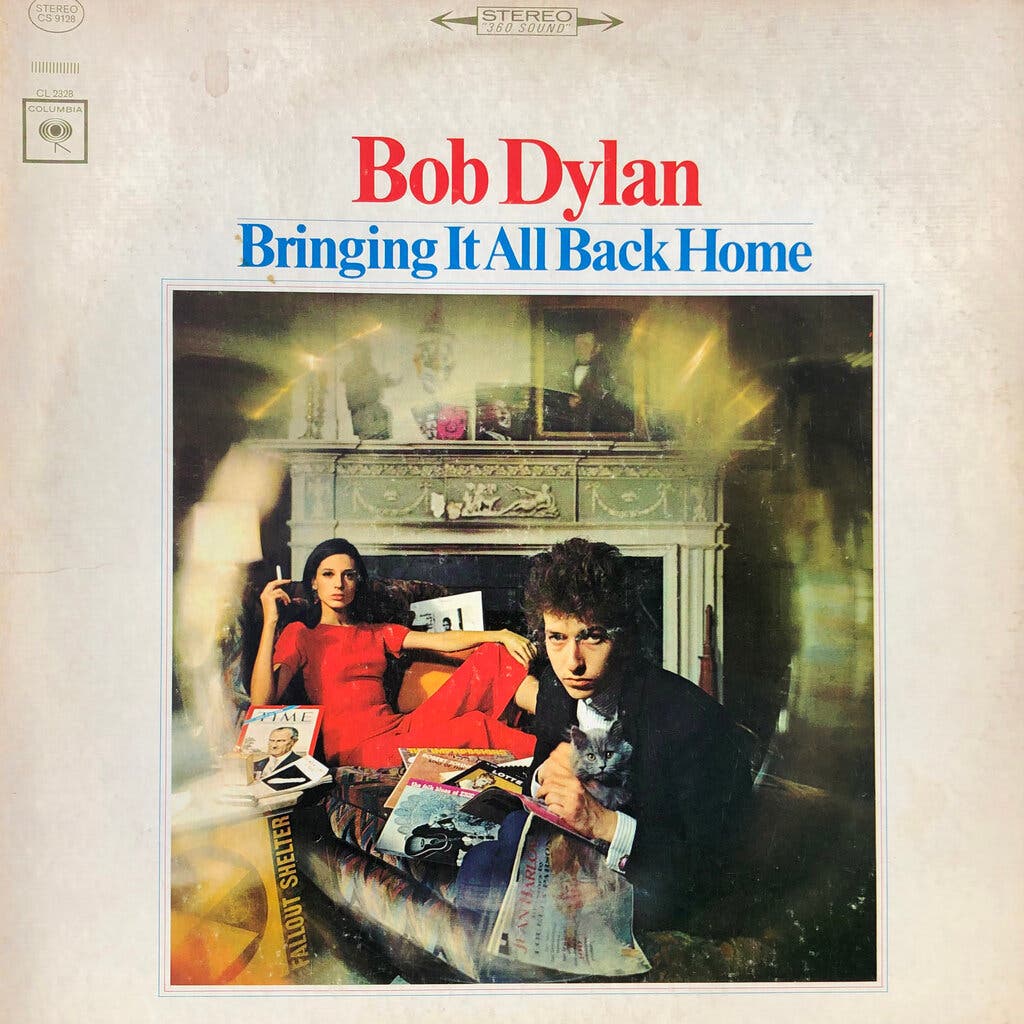
Bob Dylan wanted his manager’s wife, Sally Grossman, to appear on the cover of his 1965 album. The photo was taken at her home in Woodstock, N.Y. The source of the image can be found here.
I had also sent links to the Nabani-Purna-Lakshman sessions to Sally Grossman, whom I first met possibly in 2010, when Charles Capwell’s book on the bauls of Bengal was being launched in Kolkata. She wrote back on 24 August 2020 to say ‘how fantastic’ it was to find these recordings and then she seemed brimming with remembrance of songs and stories from the past, because the mention of Lila Ray prompted her to write ‘Lila Ray was great. Spoke about Nabani.. not a great voice but oh so charismatic a singer.’ Sally remembered Purna, Lakshman, Sudhananda, Hare Krishna, Jibon Das in Bearsville and the Bengali Bauls at the Big Pink. ‘Like with the Elektra record, some thought they were being cheated out of income but of course the truth was even if popular with some people, it didn’t sell a lot. No real money after recording costs, album production, travel, … hard to understand that I guess.’
She sent me a song.
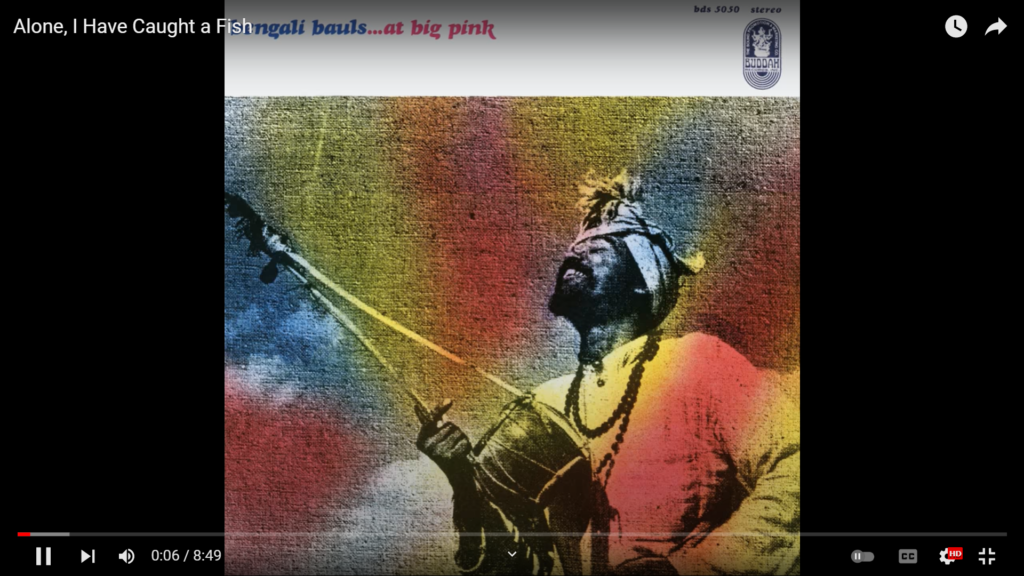
Sally sent me something about the Canadian multi-instrumentalist Garth Hudson, who had produced the Bengali Bauls at the Big Pink (1969) album. In an interview, Garth had said about the bauls: ‘We were also listening to East Indian music a little bit, and the Bengali Bals [sic.], which is more basic than the sitar music from the north. They’re from an area near Bengal in India. Albert [Grossman] had them over – he was Bob Dylan’s manager. […] Perna daus, Luxman –this was the early group – and Hari Krishna Das… Was there five of them or three? Luxman is back in his home town. He is a real ball. He is exceptional. His town people revere him. Perna is the laureate, the bell cantor, and he goes all over the world. He is successful, he comes to America often. He plays a kramk. There are three or four spellings to be found. It’s unique and is from that area. It’s the only place you’ll find it in India. It’s a great instrument. My percussionist Steve said, “What is that sound?” He heard it on the record. I said it was a kramk. He’d never heard of it. He said, “I gotta get one!” They’re Latin players – I got two in the section, Ernie Colon and Steve Elson. It’s a wild sounding thing. I won’t describe it to you. Look it up. You’ll hear it on ‘The Seas Of The North’. We’ll just leave it at that.’
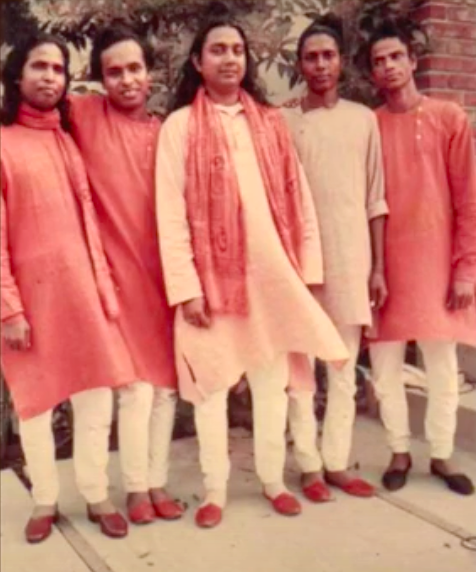
Left to right, Hare Krishna Das Baul, Jiban Krishna Mondal, Purna Das Baul, Lakshman Das Baul, Sudhananda Das Baul . Source: Purna Das’ family
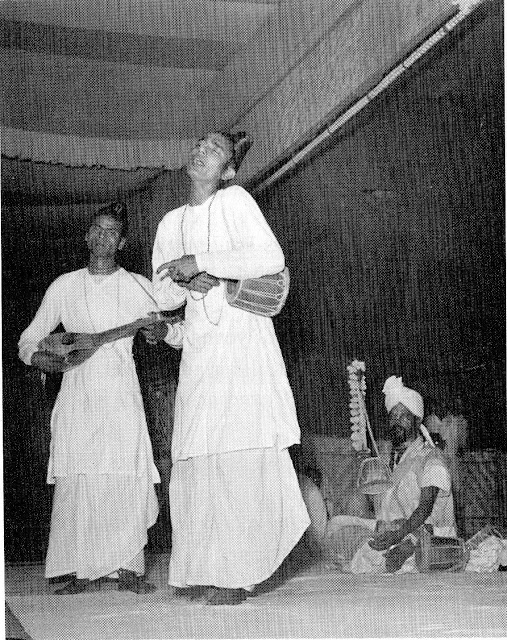
This would be an image from the time of Arnold Bake’s 1956 recording at Banga Sanskriti Sammelan. If not exactly then but around that time. Purna and Sudhananda play and sing, Nabani Das Baul, sitting on the floor, looks on. Source: Purna Das’ family
Sally had also written this little footnote in her email of 24 August 2021: And the $5K I brought from Garth Hudson for Bengali Bauls at Big Pink …
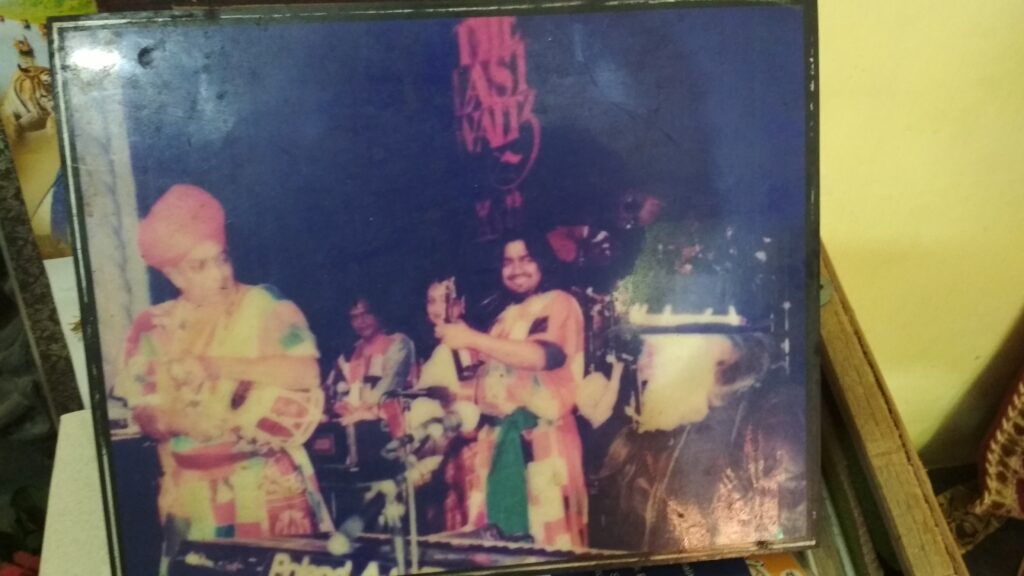
From the wall of Purna Das Baul’s home in Dhakuria, Kolkata in 2019
When I met Purna Das Baul and his son Chhoton in 2019 to talk about Arnold Bake’s baul recording from 1956, we journeyed through history and remembrance. Chhoton showed me a photo from when they had been invited by Garth Hudson to perform at the opening of the digitised version of The Last Waltz, Martin Scorcese’s film on the band called The Band. He talked about limousines and red carpets. But they had no photographs of the event apart from this hazy one, which they had mounted on their wall. I heard a lot of talk that day of lost photographs and recordings and unpaid royalties and researchers writing their thesis on baul studies and so on.
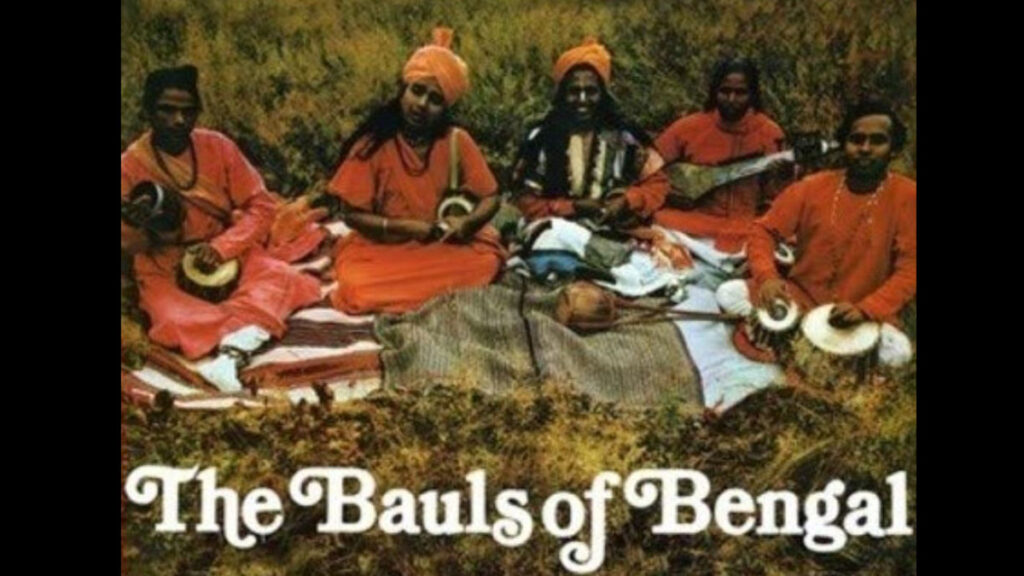
Among the names which came up in Purna Das Baul’s conversation that day on 6 May 2019 were those of Charles Capwell, Sally Grossman and Professor Dimock. Names, like new lands, had entered the soundscape of these travelling minstrels.
Before the trip to the USA in 1967, the voices of Nabani Das Baul and his sons had already travelled to Europe and America. For example, there was this record.
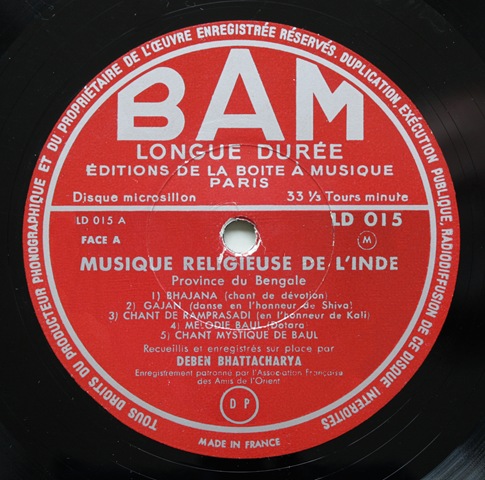
Nabani Das Baul was recorded in 1954 by Deben Bhattacharya and the recordings of Nabani and Purna and Lakshman/Luxman had been put in various anthologies released in France and elsewhere from the fifties onwards.
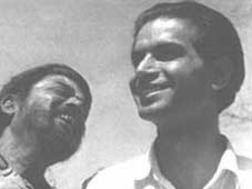
Song collector and field recordist Deben Bhattacharya with Nabani Das Baul, photographed by Richard Lannoy, possibly in Nabani Das’ home near Suri in 1954.
What kind of baul and other folk songs used to be recorded in Bengal prior to the 1950s, both commercial and non-commercial? Finding the Nabani Das record and then following conversations with Purna Das provoked the question. I re-read Amitabha Ghosh’s 1999 essay, ‘Pre-Commercial Era of Sound Recording in India’ published in the Indian Journal of History of Science, 34(1) and searched and found on the internet this iconic photograph of mostly people from the ruling elite class, listening to the phonograph in 1892, that Ghosh writes about. ‘The year 1892 has left us with a visual document of the phonograph in India. This is a photograph dates 22 May and was taken by Lala Deen Dayal in Hyderabad.’
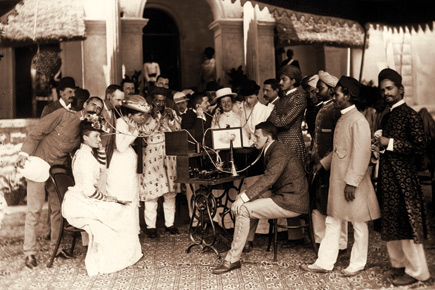
The phonograph in India photographed by Raja Lala Deen Dayal (1844-1905). A Hyderabadi Nawab and his friends listening to the phonograph on 20 May 1891, according to Wiki Commons, from where this image has been sourced. Whether the date was 22 May 1892 or 20 May 1891, I have not been able to find out.
Ghosh writes about how the Bengali poet, singer and journalist Nalinikanta Sarkar (1889-1984) had an experience of listening to a phonograph in a tent in a village fair in Murshidabad. The bifurcated pipe from the box with holes, which looked ‘something like a stethoscope used by physicians’ was plugged into his ears. ‘Within a few seconds the machine started to sing, Aar ghumao na man, mayaghore aar katakal rabe achetan’. Who might have recorded such a song? Ghosh also writes about a bhatiyali or boatman’s song ‘Majhi tor baitha ne re ami aar baite parlam na’, that had been recorded in 1902 by Hemen Bose ‘Whether these recordings as well as other contemporary ones were commercially released as H. Bose’s records from his Talking Machine Hall, 41 Dharamatalla Street (presently Lenin Sarani), cannot be ascertained,’ Ghosh writes.
Interestingly, my friend, sound artist, musician and record collector Robert Millis, shared with me a recording from around 1908 of this very song, ‘Mon majhi tor baitha ne re’, sung by ‘Mr. J. N. Bose (amateur)’.
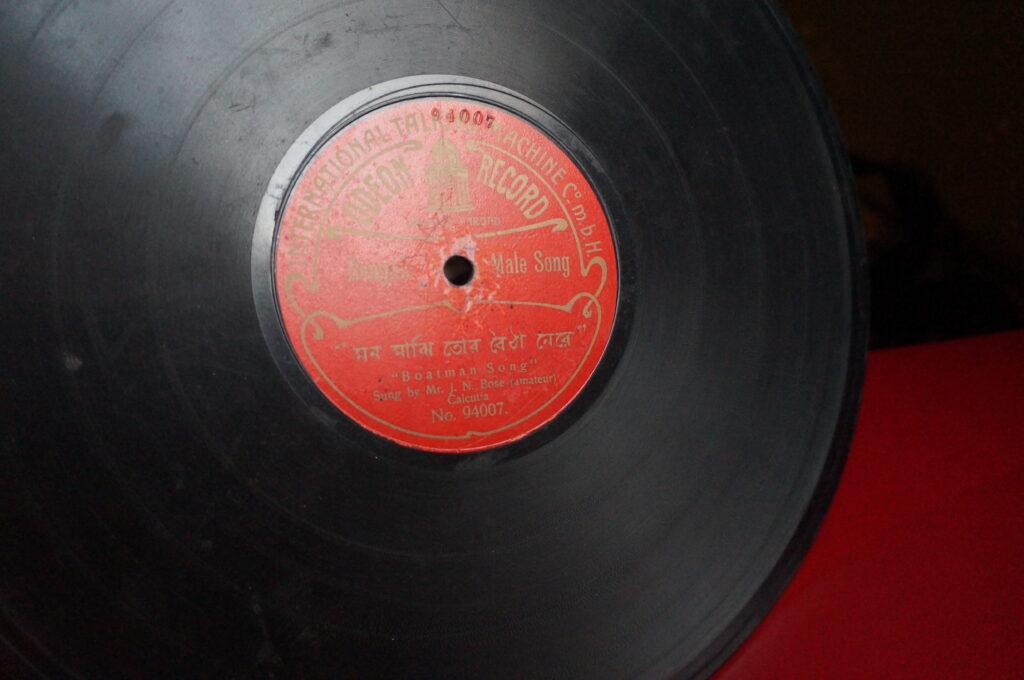
In his book Indian Talking Machine, Robert Millis writes about a 78 rpm by M. N. Ghosh, alias Monta Babu, recorded in 1919. He had asked me to listen to it and asked for my impression. While I am no expert, I could hear both the khamak and the harmonium in the recording. The melody and even in the way the words are pronounced, the singer seems like a trained urban artiste to me, affecting baul ways, incorporating baul sounds into his work, but creating a song for the record company, to sell to buyers of 78s who would have a gramophone record player in their homes, I told him.
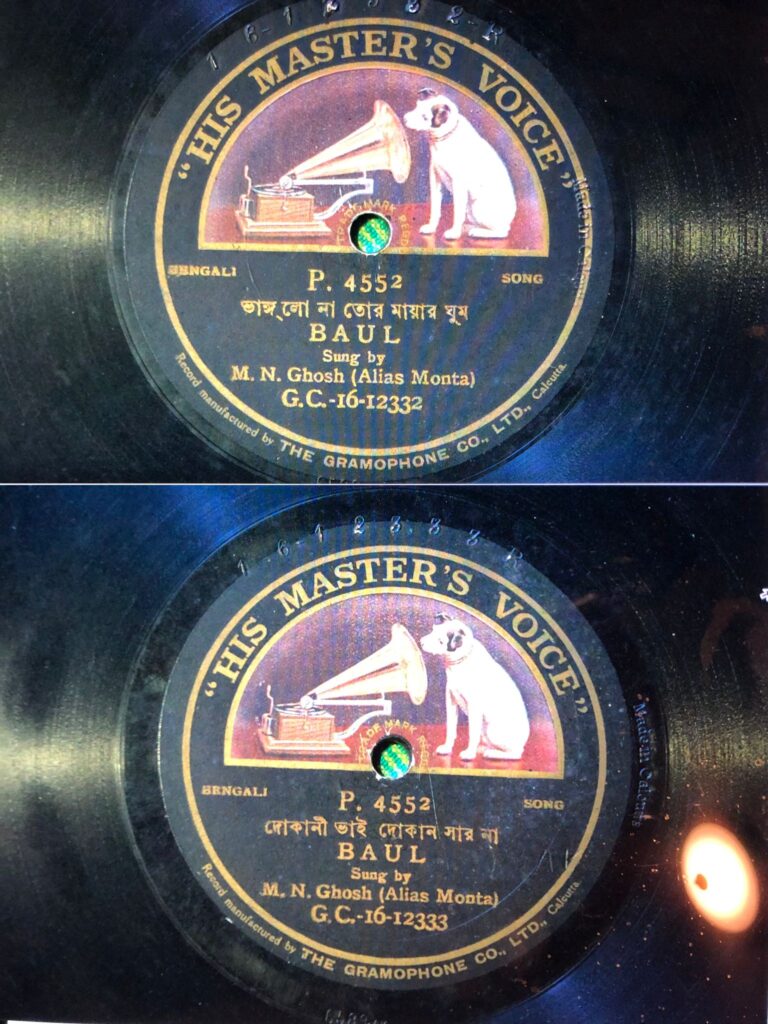
Songs on both sides of 78 rpm disc; the songs have been described as baul. The digital copies were shared with me by Robert Millis
These recordings were clearly paving the way for the records of baul and bhatiyali which began to come out in the 1950s. There are the Deben Bhattacharya recordings of Nabani Das and Purna from two years before Bake’s. There are Bake’s own wax cylinders from Kenduli. There might well have been other recordings, things we will unearth in the future, not me perhaps but others–recordings tucked away in someone’s home or archive.
On 6 May 2019, during our conversation, Purna Das Baul was telling me how he had been recorded for the first time in May 1956, which would be after Arnold Bake had recorded them at the Banga Sanskriti Sammelan in February-March that year. This was a Hindustan Record, H1639, a 78 rpm disc, with ‘Eto loke periye gelo’ on one side and ‘Majhigiri jani bhalo’ on the other.
In 2005, The Travelling Archive had recorded Debdas Baul singing ‘Majhigiri’ in Santiniketan.
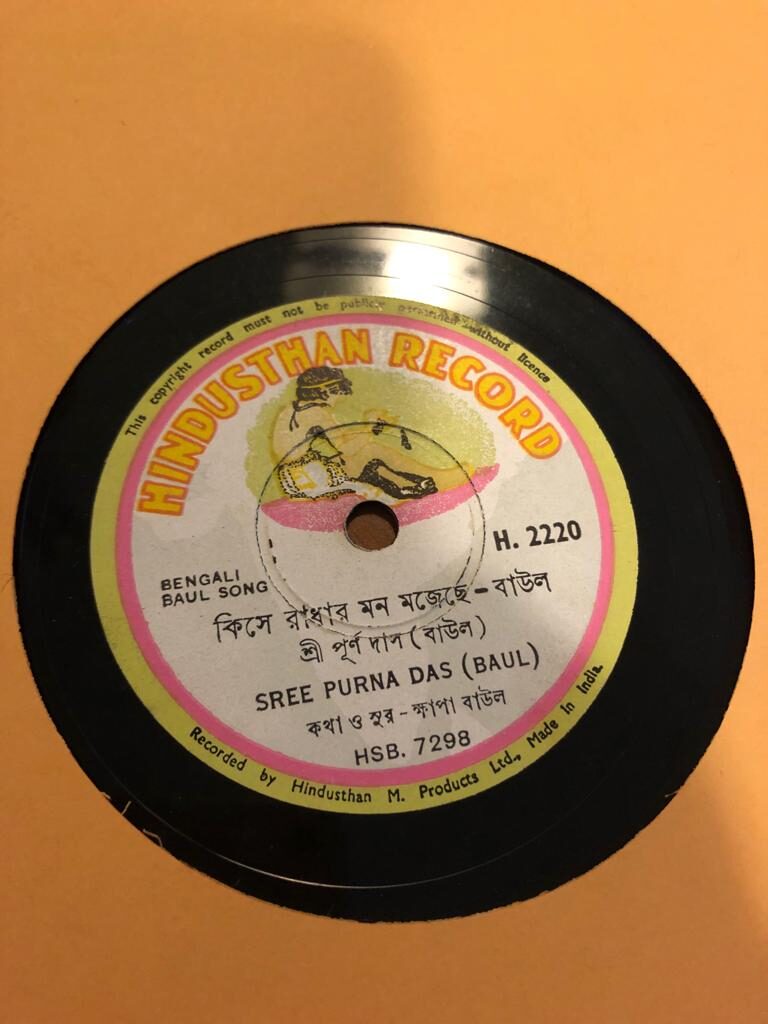
This record will be from the early 1960s.
Purna Das Baul had told us how at first, he failed the audition and how the record company was quite keen to have Radharani, and how she declined the offer, since her younger brother did not pass the test. Radharani was also recorded by Arnold Bake in 1956.
These images have been shared with me by Purna Das Baul’s family. Radharani sings here with her husband Gopal Das, who was also on Arnold Bake’s tape.
